iPod Nano
iPod Nano 6th generation |
|
| Manufacturer | Apple Inc. |
|---|---|
| Type | Portable Media Player |
| Retail availability | 7 September 2005–present |
| Media | Flash memory from 1 to 16 GB (currently 8 and 16 GB) |
| Operating system | 1.3.1 (1st Generation) 1.1.3 (2nd Generation) 1.1.3 (3rd Generation) 1.0.4 (4th Generation) 1.0.2 (5th Generation) |
| Power | Lithium ion battery |
| Display | 176 x 132 1.5" color LCD (1G/2G) 320 x 240 2" color LCD 3G 240 x 320 2" color LCD 4G 240 x 376 2.2" color TFT-LCD 5G 240 x 240 1.5" color TFT-LCD 6G |
| Input | Click Wheel / Accelerometer / Multi-Touch |
| Connectivity | iPod 30-pin or 32-pin Dock Connector USB 2.0 (wireless remote receiver) 3.5mm headphone jack |
| Predecessor | iPod Mini |
| Related articles | iPod classic iPod shuffle iPod touch |
The iPod Nano (trademarked, marketed, and stylized as iPod nano) is a portable media player designed and marketed by Apple. The first generation of the iPod Nano was introduced in the end of 2005 as a replacement for the iPod mini.[1] It uses flash memory, like the iPod Shuffle, but with a 39.1 millimetres (1.54 in) square 240x240 display on the 6th Generation, and a "Multitouch" display, similar to the one found on the iPod Touch.The iPod Nano has gone through six models, or generations, since its introduction. The sixth (current) generation supports FM radio, a pedometer, and a new "multitouch" interface to replace the traditional iPod click wheel, but it no longer supports video playback or includes a camera.
Contents |
Supported audio formats
- AAC (16 to 320 kbps)
- Protected AAC (from the iTunes Store)
- MP3 (16 to 320 Kib/s, including variable bitrate files)
- Audible (formats 2, 3 and 4)
- Apple Lossless
- AIFF
- WAV
- MP4
History
Development work on the design of the iPod Nano started only nine months before its launch date.[2] The Nano was launched in two colors (black and white) with two available sizes: 2 GB (roughly 500 songs) and 4 GB (1000 songs).[1] On February 7, 2006, Apple updated the lineup with the 1 GB model (240 songs).[3] Apple also released some accessories, including armbands and silicone "tubes" designed to bring color to the Nano and protect it from scratches, as well as a combination lanyard-earphone accessory that hangs around the neck, and avoids the problem of tangled earphone cords.
Electronics
The iPod Nano uses general-purpose integrated circuits (IC) instead of smaller, low-cost custom-developed chips, possibly to reduce time-to-market. This design, however, increases the number of electronic components and increases the cost. Japanese engineers estimated the component cost of the 2 GB Nano as between JP¥ 22,000 and JP¥ 27,000 (US$ 185-US$ 227), which was high compared to the retail price of JP¥21,800 (US$183) at the time. The cost of 2 GB Nano flash memory was about JP¥14,000 (US$118). Apple also opted for the 0603 (1.6x0.8 mm) surface mount technology which was just beginning widespread use in mobile phones in 2005.[4] The iPod Nano uses a PortalPlayer PP5021C "system on a chip" with dual embedded 80 MHz ARM 7TDMI processors.[5]
Criticism
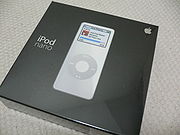
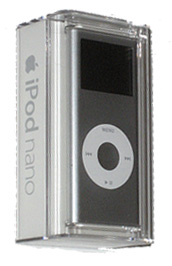
The initial consumer response to the iPod Nano was overwhelmingly positive and sales were heavy.[7] The Nano sold its first million units in only 17 days, helping Apple Inc. to a record billion-dollar profit in 2005.[8]
Apple's release of the iPod Nano as a replacement for the iPod Mini was viewed by many as a risky move.[9] Steve Jobs has argued that the iPod Nano was a necessary risk since competitors were beginning to catch up to the iPod Mini in terms of design and features, and believed the iPod Nano would prove to be even more popular and successful than the iPod Mini.
Within days of the Nano's release, some users reported damage to the Nano, suggesting that the LCD screen had become so scratched that it was unreadable, even when the backlight was on. Many have reported fine scratches on their Nano caused by microfiber cloths. Other owners reported that their Nano's screen cracked with no provocation.[10] On 27 September 2005, Apple confirmed a small percentage ("less than 1/10 of 1 percent") of iPod Nanos shipped with a faulty screen and agreed to replace any Nanos with cracked screens, but denied the iPod Nano was more susceptible to scratching than prior iPods.[11] Apple started shipping iPod Nanos with a protective sleeve to protect them from scratches. In October 2005 a class action lawsuit was filed against Apple, with the plaintiffs seeking reimbursement for the device, legal fees, and "unlawful or illegal profits" from sales of the iPod Nano. Lawyers for the plaintiffs claim that the devices "scratch excessively during normal usage, rendering the screen on the Nanos unreadable, and violating state consumer protection statutes".[12] Similar lawsuits were later filed in Mexico and the United Kingdom.[13] As of early 2009, Apple is in the process of settling a court case over the scratched iPod Nano screens, it has been suggested for Apple to set aside $22 million to refund users. A Judge will need to sign off the terms by 28 April 2009.[14] Some commentators such as BusinessWeek's Arik Hesseldahl have criticized the lawsuits. Hesseldahl dismissed them as "stupid" and suggested that they benefitted "no one but the trial lawyers," but also suggested that Apple could have avoided litigation by offering "full refunds on unwanted Nanos" instead of charging a re-stocking fee and lengthening the return period from 14 days (when purchased through Apple retail or online) to 30 or 60 days.[15]
Incidents
In Australia, an iPod Nano caught fire while being charged on a PC.[16][17] Since the limited warranty was over, the consumer was not able to get a replacement right away.
Another iPod incident happened in the Hartsfield-Jackson Atlanta International Airport while a man was working in the airport.[18] His iPod Nano set his trousers on fire. Apple Inc., refused to release a statement regarding this issue.
In addition, an iPod Nano sparked in Japan in January while it was recharging.[19] Although no one was injured during the incident, Apple Inc. investigated the incident.[20] It was reported on 19 August 2008 that 17 incidents of abnormal overheating with first-generation iPod Nano units while recharging had been reported in Japan, including cases in which tatami mats had been charred.[21] On August 10, 2010, Apple Japan released a statement saying that it would replace any iPod Nanos that overheat.[22][23]
Generations
First generation
Advertising emphasized the iPod Nano's small size: it is 40 millimetres (1.6 in) wide, 90 millimetres (3.5 in) long, 6.9 millimetres (0.27 in) thick and weighs 42 grams (1.5 oz). Its stated battery life is up to 14 hours. The screen is 176 x 132 pixels, 38 millimetres (1.5 in) diagonal, and can display 65,536 colors (16-bit color).[1]
Second generation
On 12 September 2006, Apple updated the Nano line. The second-generation Nano features scratch-resistant, anodized aluminium casing like the earlier Mini's design; the multiple color choices (silver, green, pink, blue, and black) mirror those of the Mini as well. However, unlike the second-generation Mini, the button labels do not match the color of the Nano. Instead, they are gray, like the first-generation Mini, except for the black iPod which has a black click wheel. The second-generation Nano features "a brighter, more vibrant display",[24] a battery life upgrade (from 14 to 24 hours), and doubled storage sizes with the new 2, 4, and 8 GB models (compared to the previous 1, 2, and 4 GB models). The second generation iPod Nanos also support gapless playback of audio files, a new search option, and a 40 percent brighter screen. The 2 GB model was available in silver only. The 4 GB was initially available in green, blue, silver, or pink. The 8 GB model was initially only available in black but Product Red was later added. Apple claims that the second generation iPod Nano's packaging is "32% lighter and uses 52% less volume than the first generation",[25] thereby reducing environmental impact and shipping cost at the same time.
On 13 October 2006, Apple announced a special edition iPod Nano Product Red, with a red exterior and 4 GB of storage. For each red iPod Nano sold in the United States, Apple donates US$10 to the Product Red initiative, while retaining the regular price.[26] On 3 November 2006, Apple introduced a red 8 GB model, due to "outstanding customer demand", while also retaining the same price point of the black model with an equally large storage capacity.[27]
On 26–27 December 2006, Apple Computer's website and servers crashed due to people downloading iTunes software since so many iPods were sold that Christmas season.
Third generation
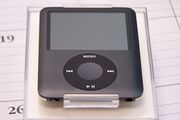
Apple updated the Nano again on 5 September 2007. The third-generation Nano featured a 2-inch (51 mm) QVGA (320 x 240) screen and a shorter, wider, heavier design, with new colors. New features included browsing via Cover Flow, a new user interface and video playback. Users had to repurchase games bought before a month prior to the debut of the new iPod as they were not supported. The Nano was announced in a 4 GB version coming in silver and an 8 GB version coming in silver, turquoise, mint green, black, and Product Red. The battery lasted for approx. 24 hours on audio playback and approx. 5 hours on video playback. On 22 January 2008, Apple released a pink version of the 8 GB iPod Nano.
Combining elements from previous generations of the iPod Nano, the third-generation Nano had an aluminum front plate and a stainless steel back plate. The Nano also sported a new Minimalistic hold switch, similar to the iPod Shuffle's power switch, which had been moved to the bottom of the player. The 2-inch (51 mm) screen had the smallest dot pitch of any Apple product, having the same pixel count as the 2.5-inch (64 mm) display of the iPod Classic.
On 6 October 2007, Apple released a firmware update (1.0.2) via iTunes that was said to improve Cover Flow and yield faster menu navigation.[28] The update was also released for the iPod Classic. On 28 November 2007, Apple released another firmware update (1.0.3) via iTunes, which included unspecified bugfixes. 15 January 2008 saw the release of version 1.1, which added support for iTunes movie rentals, music song lyrics support and included more unspecified bugfixes. In May 2008, Apple released update version 1.1.2 with even more bug fixes.
Fourth generation
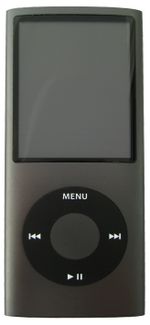
At the Apple Let's Rock Event on September 9, 2008, the iPod Nano 4th Generation was officially announced.[29] It returned to the narrow form factor of the 1st and 2nd Generation model, while retaining and rotating the 51 millimetres (2.0 in) screen from the 3G model. It was also thinner than the 1G, 2G and 3G, measuring 90.7 millimetres (3.57 in) tall by 38.7 millimetres (1.52 in) wide by 6.2 millimetres (0.24 in) thick, and weighing 36.8 grams (1.30 oz). It had a curved aluminum shell and glass screen (the glass screen being held in place with nothing but the shell). Apple claimed the battery would last 24 hours of music playback, and only 4 hours of video playback, compared to the 5 hours of the previous generation.
The six previous colors (silver, black, mint, turquoise, berry red, and rose pink) were replaced by silver, black, purple, light blue, green, yellow, orange, red, and pink, for a total of nine, although the Product Red color was only available directly from Apple (website and retail stores). Apple marketed the new colors as "nano-chromatic". Also added was an accelerometer which allows the Nano to shuffle songs by shaking it, the option between portrait and landscape display modes by tilting the iPod left or right, and access to Cover Flow when tilted sideways.[30] Videos, however, could only be played in landscape mode. The user interface was also refreshed, adding a more stylized look in keeping with the new hardware design. It included a new voice recording feature which started automatically when an Apple compatible microphone is plugged in. It also included the new "Genius" feature, introduced by Apple the same day. The Genius feature automatically creates playlists based on a selected song using an algorithm built by Apple.
It was additionally touted as "the most environmentally friendly iPod Apple has ever made", containing arsenic-free glass and a BFR-, mercury-, and PVC-free design. It was also claimed to be highly recyclable. The iPod Nano 4G was shipped in cases similar to the 2G ones with the clear view in the front, and is marketed in two models: 8 GB and 16 GB. Limited quantities of an unannounced 4 GB model surfaced in various markets.[31] Also, the iPod Quiz game was dropped and replaced with a Maze game which makes use of the iPod's accelerometer similarly to such games on the iPhone and iPod Touch.
The fourth generation dropped support for charging via FireWire. "This change means that any dock accessories that use the dock connector's FireWire pins to send power—many older speakers and car chargers, for example—will not charge the 4G iPod Nano."[32]
Fifth generation
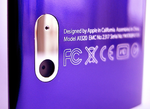
At Apple's September 9, 2009 event, a fifth generation iPod Nano was unveiled with reduced prices on the larger model (at the time of release, the 8GB was priced at $149 and the 16GB at $179),a larger, 55.8 millimetres (2.20 in) diagonal screen (up from 50.8 millimetres (2.00 in) in third and fourth generation iPod Nanos), which is also wider,[33] integrated video camera with special effects, microphone, FM Radio with iTunes tagging (via RDS) multiple radio regions including Americas, Asia, Australia, Europe, and Japan.
It also includes Live Pause, a built-in pedometer, Nike+iPod Support and speaker (features more anticipated with the iPod Touch).[33][34]
The headphone jack and dock connector swapped locations so that the headphone jack is now to the left of the dock connector. Therefore the fifth generation iPod Nano uses a different Apple Universal Dock insert than the fourth generation.[35]
The fifth generation iPod Nano has nine finishes: Silver, Black, Purple, Blue, Yellow, Orange, Product Red, Green and Pink. All have a glossier finish than the fourth generation. Just like the 4G iPod Nano, Product Red and the yellow Nano are only available on the Apple Online Store and Apple Retail Store .
Sixth generation
At a media event on September 1, 2010, Apple announced the sixth generation iPod Nano, which among many new features, will be designed around a high resolution "square shaped" touch-screen.[36]
Some notable changes are as follows: the device now features a smaller 1.54 inch lower resolution (higher pixel density) screen which supports multi-touch, as opposed to the 2.2 inch screen on the iPod nano 5g. The device supports over 24 hours of music playback on a single charge. The device retains the same 30-pin dock connector as previous generations. The new iPod Nano does not support video playback.[37] Additionally, the device no longer has a camera or voice recorder, as Apple's market research determined that many customers rarely used those features in the previous generation devices. The iPod Nano lost its built in speaker. The 6th generation iPod is at the same price point as the 5th generation device. It still includes Nike fitness option and the FM Radio Tuner. It has the black on white screen contrast option.
Specifications
| Generation | Pictures | Capacity | Colors | Connection | Original release date | Minimum OS to sync | Rated battery life (hours) | Screen (pixels) | Onboard RAM | Physical Size | Weight |
|---|---|---|---|---|---|---|---|---|---|---|---|
| 1 | 1 GB | Black White |
USB (FireWire for charging only) |
7 February 2006 | Mac: 10.3.4 Windows: 2000[38] |
Audio: 14 Slideshow: 4 |
176 x 132 0.168 mm dot pitch |
32 MB | 89 mm 41 mm 6.9 mm |
42.5 g (1.5 oz) |
|
| 2 GB | 7 September 2005 | ||||||||||
| 4 GB | |||||||||||
| Replaced Mini. Color screen for picture viewing; 1 GB version released later. | |||||||||||
| 2 | 2 GB | Silver | USB (FireWire for charging only) |
12 September 2006 | Mac: 10.3.9 Windows: 2000[39] iTunes 7 or later |
Audio: 24 Slideshow: 5 |
176 x 132 .168 mm dot pitch. |
32 MB | 89 mm 41 mm 6.6 mm |
40 g (1.41 oz) |
|
| 4 GB | Silver Blue Green Pink |
||||||||||
| (Product) Red Special Edition* | 13 October 2006 | ||||||||||
| 8 GB | Black | 12 September 2006 | |||||||||
| (Product) Red Special Edition* | 3 November 2006 | ||||||||||
| Anodized aluminium casing with plastic top and bottom; 6 colors available. | |||||||||||
| 3 | 4 GB | Silver | USB (FireWire for charging only) |
5 September 2007 | Mac: 10.4.8 Windows: XP, Vista, 7 iTunes 7.4 or later |
Audio: 24 Video: 5 |
320 x 240 204 ppi |
32 MB | 70 mm 52 mm 6.6 mm |
49.3 g (1.74 oz) |
|
| 8 GB | Silver Light Blue Light Green Black (Product) Red Special Edition* |
||||||||||
| Pink | 22 January 2008 | ||||||||||
| 51 mm QVGA screen; lighter color shades and chrome back; new interface; video-playing capability. | |||||||||||
| 4 | 8 GB | Silver Black Purple Blue Green Yellow Orange Pink (Product) Red Special Edition* |
USB | 9 September 2008 | Mac: 10.4.11 Windows: XP, Vista, 7 iTunes 8 or later |
Audio: 24 Video: 4[37] |
240 x 320 204 ppi |
32 MB | 91 mm 38 mm 6.1 mm |
36.8 g (1.3 oz) |
|
| 16 GB | |||||||||||
| Curved enclosure and new colors; revised interface; voice recording features; "shake to shuffle"; accelerometer; limited 4 GB models [31] | |||||||||||
| 5 |  |
8 GB | Silver Black Purple Blue Green Yellow* Orange Pink (Product) Red Special Edition* |
USB |
9 September 2009 | Mac: 10.4.11 Windows: XP, Vista, 7 iTunes 9 or later |
Audio: 24 Video: 5[37] |
240 x 376 204 ppi 0.3 megapixel camera |
64 MB | 91 mm 38 mm 6.1 mm |
36.3 g (1.28 oz) |
| 16 GB | |||||||||||
| Polished aluminium case including a larger screen, video camera, FM radio tuner, and a pedometer. Retains entire color line as fourth generation (except green is deeper). | |||||||||||
| 6 | 8 GB | Silver Graphite Blue Green Orange Pink (Product) Red Special Edition* |
USB |
8 September 2010 | Mac: 10.5.8 Windows: XP, Vista, 7 iTunes 10 or later |
Audio: 24[37] | 240 x 240 220 ppi |
64 MB | 37.5 mm 41 mm 8.78 mm |
21.1 g (0.74 oz) |
|
| 16 GB | |||||||||||
| Multi-touch screen. No click-wheel, camera, voice recorder or video playback. Same price range as the 5th generation, except in Europe. | |||||||||||
- * - Apple Store exclusive
Timeline of compact iPod models

See also
- Nike+iPod
- iTunes
- iPhone
- iPod touch
- iPod Mini
References
Technical specifications
Footnotes
- ↑ 1.0 1.1 1.2 Apple (2005-09-07). "Apple Introduces iPod Nano". Apple press release. http://www.apple.com/pr/library/2005/sep/07ipodnano.html. Retrieved 2006-12-23.
- ↑ Grossman, Lev (2005-09-12). "Stevie's Little Wonder". Time. http://www.time.com/time/magazine/article/0,9171,1103572,00.html. Retrieved 2006-10-03.
- ↑ "Apple Unveils New 1 GB iPod Nano at $149". Apple press release. Apple Inc.. 2006-02-07. http://www.apple.com/pr/library/2006/feb/07ipod.html. Retrieved 2006-12-23.
- ↑ Hirotaka Itoh; Naoki Asakawa (December 2005). "Looking Inside iPod nano, Game Boy Micro". Nikkei Electronics Asia. http://techon.nikkeibp.co.jp/article/HONSHI/20061122/124204/. Retrieved 2007-07-19.
- ↑ EveryMac.com. "Apple iPod nano 1GB, 2GB, 4GB Specs (MA004LL/A*)". http://www.everymac.com/systems/apple/consumer_electronics/stats/ipod_nano.html. Retrieved 2007-10-18.
- ↑ "Apple and the Environment". Apple.com. Apple Inc.. http://www.apple.com/environment/design/. Retrieved 2006-10-22.
- ↑ Michelle Myers (2005-09-10). "Apple store buzzes with Nano fever". CNet. http://news.com.com/2100-1041_3-5858457.html. Retrieved 2005-09-15.
- ↑ Daniel Drew Turner (2005-10-11). "Apple Hits $1 Billion in Profit for 2005". eWeek. http://www.eweek.com/article2/0,1895,1870027,00.asp. Retrieved 2006-01-03.
- ↑ Burrows, Peter (2005-09-13). "iPod nano: Will small size mean big sales?". BusinessWeek. http://www.businessweek.com/the_thread/techbeat/archives/2005/09/ipod_nano_will.html?campaign_id=rss_blog_techbeat.
- ↑ Angell, Larry (2005-09-25). "iPod nano screen complaints abound". iLounge. http://ilounge.com/index.php/news/comments/ipod-Nano-screen-complaints-abound/. Retrieved 2005-09-27.
- ↑ Jim Dalrymple (2005-09-27). "Apple responds to iPod Nano screen concerns". Macworld. http://www.macworld.com/news/2005/09/27/nanoscreen/index.php. Retrieved 2005-09-28.
- ↑ Kasper Jade; Katie Marshal (2005-10-21). "iPod Nano owners sue Apple over screen issues". AppleInsider. http://www.appleinsider.com/article.php?id=1340. Retrieved 2005-10-21.
- ↑ "Nano lawsuit goes international". BBC News. 2005-11-08. http://news.bbc.co.uk/2/hi/technology/4417344.stm. Retrieved 2006-05-10.
- ↑ Apple Settles iPod Nano Scratch Lawsuit with $25 Refund
- ↑ Hesseldahl, Arik (2005-10-27). "iPod nano Lawsuits: Who Wins?". BusinessWeek. http://www.businessweek.com/technology/content/oct2005/tc20051027_665544.htm. Retrieved 2005-11-08.
- ↑ Exploding iPod dies gruesome death, Engadget.
- ↑ Gadgets: iPod nano Explodes During Charge, Gizmodo.
- ↑ iPod Sets Man's Pants On Fire – News Story – WSB Atlanta
- ↑ iPod nano Sparks Investigation in Japan – GridLock – Just another KM / Tech Blog
- ↑ iPod nano emits sparks, Japan's government says, Tech News on ZDNet.
- ↑ ???iPod?????????17? (17 overheating incidents involving old iPods while recharging), JNN News, (19 August 2008). Retrieved on 19 August 2008. (Japanese)
- ↑ "Apple says to replace overheating iPods in Japan". Reuters. http://www.reuters.com/article/idUSTRE67A1DL20100811. Retrieved 2010-09-02.
- ↑ Koh, Yoree (2010-08-12). "Apple Japan to Swap iPods that Overheat - WSJ.com". Online.wsj.com. http://online.wsj.com/article/SB10001424052748704901104575423140720329642.html. Retrieved 2010-09-02.
- ↑ "Apple Introduces the New iPod Nano". Apple press release. Apple Inc.. 2006-09-12. http://www.apple.com/pr/library/2006/sep/12nano.html. Retrieved 2006-12-18.
- ↑ Apple – Environment
- ↑ "Apple Announces iPod Nano (PRODUCT) RED Special Edition". Apple press release. Apple Inc.. 2006-10-13. http://www.apple.com/pr/library/2006/oct/13red.html. Retrieved 2007-01-13.
- ↑ "Apple Announces New 8GB Model of iPod Nano (PRODUCT) RED Special Edition". Apple press release. Apple Inc.. 2006-11-03. http://www.apple.com/pr/library/2006/nov/03nano.html. Retrieved 2007-01-07.
- ↑ "iPod Classic, Nano updated to 1.0.2". MacNN. October 6, 2007. http://www.macnn.com/articles/07/10/06/ipod.classic.nano.102/. Retrieved 2008-01-22.
- ↑ Ricker, Thomas (2008-09-09). "Official: iPod nano reaches 4G, looks tall for its age". Engadget. http://www.engadget.com/2008/09/09/official-ipod-nano-reaches-4g-looks-tall-for-its-age/. Retrieved 2008-09-12.
- ↑ "Identifying the 4th Generation iPod nano". About.com. http://ipod.about.com/od/understandingipodmodels/g/4g_nano.htm. Retrieved 2009-04-29.
- ↑ 31.0 31.1 Topolsky, Joshua (2008-09-17). "Official : Mysterious new 4GB iPod nano 4Gs begin appearing on store shelves". Engadget. http://www.engadget.com/2008/09/17/mysterious-new-4gb-ipod-nano-4gs-begin-appearing-on-store-shelve/. Retrieved 2008-09-17.
- ↑ Frakes, Dan (2008-09-16). "Fourth-generation iPod Nano". PC World. http://www.pcworld.com/article/151113/fourthgeneration_ipod_nano.html.
- ↑ 33.0 33.1 iPod nano new features
- ↑ "iTunes - Partner with iTunes". Apple. http://www.apple.com/itunes/tagging/. Retrieved 2010-09-02.
- ↑ "Learn about Apple Universal Dock". Support.apple.com. 2010-04-22. http://support.apple.com/kb/HT1380. Retrieved 2010-09-02.
- ↑ "Apple unveils new TV box for renting movies, shows - Yahoo! News". News.yahoo.com. http://news.yahoo.com/s/ap/20100901/ap_on_hi_te/us_tec_apple. Retrieved 2010-09-02.
- ↑ 37.0 37.1 37.2 37.3 "iPod nano - Read the technical specifications". Apple. http://www.apple.com/ipodnano/specs.html. Retrieved 2010-09-02.
- ↑ "Apple Introduces iPod nano". Apple Inc. 7 September 2005. http://www.apple.com/pr/library/2005/sep/07ipodnano.html. Retrieved 1 March 2010.
- ↑ "Apple Introduces the New iPod nano". Apple Inc. September 12, 2006. http://www.apple.com/pr/library/2006/sep/12nano.html. Retrieved March 1, 2010.
- ↑ Apple Inc., Apple press release library, Retrieved September 19, 2007.
- ↑ Mactracker (mactracker.ca), Apple Inc. model database, version as of 26 July 2007.
External links
|
||||||||||||||||||||
|
||||||||||||||||||||||||||||||||
|
|||||||||||||||||